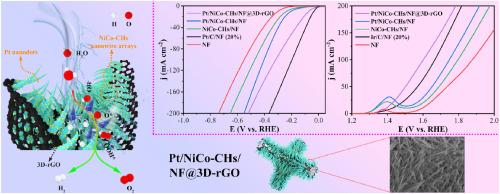多孔氧化石墨烯基体上铂纳米点修饰氢氧化镍纳米线调控的高效整体水分解电极
IF 8.3
2区 工程技术
Q1 CHEMISTRY, PHYSICAL
引用次数: 0
摘要
我们报道了一种通过在三维多孔还原氧化石墨烯(3D-rGO)基体上用铂(Pt)纳米点修饰碳酸钴氢氧镍纳米线(NiCo-CHs)阵列来构建OWS电极的新策略。Pt纳米点的掺入导致NiCo-CHs的电子态发生了实质性的调制,导致了有利于OWS的协同异质结构。3D-rGO的引入提高了导电性,促进了电荷转移,并为活性成分的沉积提供了丰富的表面位点。因此,具有多维异质结构的电极具有显著的双功能电催化活性,在−10 mA cm−2时HER的过电位为73 mV,在50 mA cm−2时OER的过电位为272 mV。此外,该电极在HER和OER中表现出优异的反应动力学,增强的电荷转移特性以及优异的稳定性和耐久性。当配置成OWS电池时,器件在10ma cm−2下可实现1.40 V的低工作电压。本文章由计算机程序翻译,如有差异,请以英文原文为准。

Efficient overall water splitting electrode regulated by Pt nanodots modified NiCo-carbonate hydroxide nanowires on porous rGO matrix
We report a novel strategy for constructing the OWS electrode by modifying nickel-cobalt carbonate hydroxide nanowires (NiCo-CHs) arrays with platinum (Pt) nanodots on a three-dimensional porous reduced graphene oxide (3D-rGO) matrix. The incorporation of Pt nanodots induces substantial modulation in the electronic states of NiCo-CHs, leading to a synergistic heterostructure that favors the OWS. The introduction of 3D-rGO enhances electrical conductivity, facilitates charge transfer, and provides abundant surface sites for the deposition of active components. Consequently, the electrode with a multi-dimensional heterostructure possesses remarkable bifunctional electrocatalytic activity, achieving low overpotentials of 73 mV for HER at −10 mA cm−2 and 272 mV for OER at 50 mA cm−2. Furthermore, the electrode exhibits superior reaction kinetics, enhanced charge transfer characteristics, and excellent stability and durability for both HER and OER. When configured into an OWS cell, the device achieves a low operating voltage of 1.40 V at 10 mA cm−2.
求助全文
通过发布文献求助,成功后即可免费获取论文全文。
去求助
来源期刊

International Journal of Hydrogen Energy
工程技术-环境科学
CiteScore
13.50
自引率
25.00%
发文量
3502
审稿时长
60 days
期刊介绍:
The objective of the International Journal of Hydrogen Energy is to facilitate the exchange of new ideas, technological advancements, and research findings in the field of Hydrogen Energy among scientists and engineers worldwide. This journal showcases original research, both analytical and experimental, covering various aspects of Hydrogen Energy. These include production, storage, transmission, utilization, enabling technologies, environmental impact, economic considerations, and global perspectives on hydrogen and its carriers such as NH3, CH4, alcohols, etc.
The utilization aspect encompasses various methods such as thermochemical (combustion), photochemical, electrochemical (fuel cells), and nuclear conversion of hydrogen, hydrogen isotopes, and hydrogen carriers into thermal, mechanical, and electrical energies. The applications of these energies can be found in transportation (including aerospace), industrial, commercial, and residential sectors.
 求助内容:
求助内容: 应助结果提醒方式:
应助结果提醒方式:


